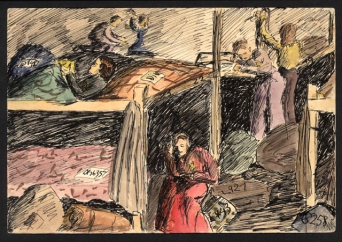Helga Hošková-Weissová (b. 1929)
listopadu 2009

Girls’ Billets in Terezín before a Visit by the International Red Cross, Terezín, 1944 pen and ink drawing with watercolour, 148 x 218 mm ŽMP 173.782
Helga Hošková-Weissová is one of the very few of the Terezín children to survive the war. She was born on 10 November 1929 in Prague, where she spent a happy childhood until the age of 12. A tragic turn of events unfolded on 7 December 1941, when Helga and her parents were put on one of the first transports to the Terezín ghetto. She took with her her crayons, watercolours and a sketch pad, as well as a diary that she started to keep under the influence of the worsening situation after the Munich Conference. After arriving in Terezín, the family was separated. Helga and her mother were placed in the Dresden Barracks along with the other women; her father lived in the Sudeten Barracks, later in the Magdeburg Barracks. It was to be seven months before the family met again – in July 1942. Helga then moved into Girls’ Home L 410 on the square next to the church, where she lived with girls of the same age in Room 24. In her free moments, she continued her diary and drawings. She often took note of seemingly unimportant details that enliven her drawings with her own story. In this way, she created a unique and particularly effective group of documents, which differ from other Terezín artworks in terms of their power to convey and their authenticity. After almost three years in the ghetto, Helga and her mother (her father had been deported on a men’s transport a little earlier, allegedly bound for a work camp) were deported to the east – first to Auschwitz, then to Freiberg near Dresden (a branch of the Flossenburg concentration camp, where women prisoners were forced to work as slaves for the manufacture of aircraft parts) and finally – after an atrocious journey on one of the evacuation transports – to Mauthausen. They were liberated there by the U.S. army on 5 May 1945. After the war, Helga attended high school and the State School of Graphic Arts. She was then admitted to the Prague Academy of Art, Architecture and Design, initially under the supervision of Emil Filla and, after the latter’s death, under Alois Fišárek. In 1965, Helga received a scholarship to visit Israel, which was to have a key influence on her later work. Most of her time there was spent at the artists’ colony Ein Hod near Haifa, but she also travelled widely through the country. Under the influence of her experience in Israel, her palette brightened and the style of her painting began to loosen up. In 1968 an exhibition of her work reflecting her time in Israel was held by the then State Jewish Museum in Prague at the Spanish Synagogue. Her promising career, however, was unexpectedly and for a long time halted by the Soviet-led occupation of Czechoslovakia in August. It was not until 1989 that Helga was able to fully resume her artwork and exhibiting. The world opened up again for her at that time. Since then, she has exhibited many times in Austria, Germany, Italy and the USA, as well as in Czechoslovakia. Her work has been featured in many foreign publications and several documentary films. A monograph has been published on her childhood drawings from Terezín and a Czech Television documentary (Maluj dokud vidíš – Paint As Long As You Can See) has been made about her life. In 1993 she was awarded an honorary doctorate from the Massachusetts College of Art in Boston. By visiting schools and talking to young people at home and abroad, Helga is actively helping to educate young people towards democracy and tolerance. As a tribute to her lifetime work, she was awarded the Josef Hlávka Medal in 2009. A retrospective exhibition of Helga Hošková-Weissová’s work is currently on view at the Robert Guttmann Gallery. This show, curated by Arno Pařík, is being held by the Jewish Museum in Prague to mark the artist’s 80th birthday.



![[subpage-banner/6_Media.png]](https://c.jewishmuseum.cz/images/subpage-banner/6_Media.png)
![[homepage-banner/incident.jpeg]](https://c.jewishmuseum.cz/images/homepage-banner/incident.jpeg)